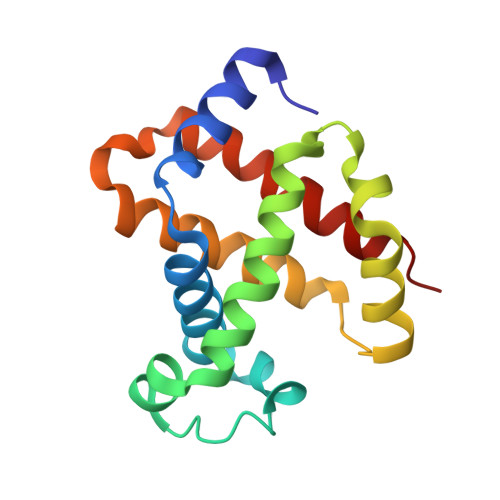Chloride ion independence of the Bohr effect in a mutant human hemoglobin beta (V1M+H2deleted).
Fronticelli, C., Pechik, I., Brinigar, W.S., Kowalczyk, J., Gilliland, G.L.(1994) J Biol Chem 269: 23965-23969
- PubMed: 7929044
- Primary Citation of Related Structures:
2HHE - PubMed Abstract:
A mutant human hemoglobin, beta (V1M+H2 delta), has been constructed. Analysis of the oxygen binding curves obtained at pH 8.3, where the Bohr effect is inoperative, indicates that this mutation results in an additional stabilization of the T-state conformation by 0.9 kcal/mol. The crystal structure of deoxy-beta (V1M+H2 delta) has been determined to 2.2-A resolution and compared with the deoxy structure of human hemoglobin at the same resolution. In human hemoglobin, a sulfate anion is anchored to the beta-chains by a complex network of H-bonds and electrostatic interactions with the amino terminus and Lys beta 82. In the mutant hemoglobin, the shortening of the amino-terminal region of the A helix by 1 residue results in the formation of an intrachain electrostatic interaction between the amino-terminal amino and Asp beta 79. This eliminates the sulfate binding site, and the sulfate is replaced by two water molecules. At variance with human hemoglobin, the alkaline Bohr effect for beta (V1M+H2 delta) is not sensitive to the presence of Cl-. This indicates that the sulfate binding site in human hemoglobin also serves as a Cl- binding site, and that the amino-terminal Val beta 1 is essential for oxygen-linked Cl- binding to hemoglobin as well as the Cl(-)-dependent Bohr effect. Analysis of the oxygen binding curves indicates that the oxygen-linked Cl- ions are released upon binding of the first oxygen molecule.
Organizational Affiliation:
Department of Biochemistry, University of Maryland Medical School, Baltimore 21201.
















